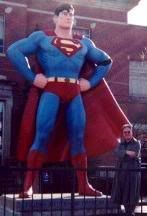| Pop Culture Gadabout | ||
|
Monday, March 02, 2009 ( 3/02/2009 12:40:00 PM ) Bill S.  "SOMEONE SINGING A CATCHY SONG." All us part-time smart guys who congratulated ourselves on catching the Brecht allusion in Watchmen's proto-EC pirate horror comic, "The Black Freighter," can pat ourselves on the back even more fervently now. With the latest installment of Alan Moore & Kevin O'Neill's The League of Extraordinary Gentlemen (Top Shelf Comix), ultra-dense scripter Moore slathers on the Threepenny Opera refs with the same allusive brazenness he brought to Bram Stoker or Jules Verne. In the first volume of the new three-book mini-series, Century: 1910 (set for April release), Moore and his artist collaborator O'Neill cut between the League's investigation into an impending menace and sequences where Brecht characters Jenny Diver (a dying Captain Nemo's daughter, we learn), Jack MacHeath a.k.a. Mack the Knife and Sukie Tawdry sing and dance to classic Brecht/Weill compositions. "SOMEONE SINGING A CATCHY SONG." All us part-time smart guys who congratulated ourselves on catching the Brecht allusion in Watchmen's proto-EC pirate horror comic, "The Black Freighter," can pat ourselves on the back even more fervently now. With the latest installment of Alan Moore & Kevin O'Neill's The League of Extraordinary Gentlemen (Top Shelf Comix), ultra-dense scripter Moore slathers on the Threepenny Opera refs with the same allusive brazenness he brought to Bram Stoker or Jules Verne. In the first volume of the new three-book mini-series, Century: 1910 (set for April release), Moore and his artist collaborator O'Neill cut between the League's investigation into an impending menace and sequences where Brecht characters Jenny Diver (a dying Captain Nemo's daughter, we learn), Jack MacHeath a.k.a. Mack the Knife and Sukie Tawdry sing and dance to classic Brecht/Weill compositions.The end results of the latter can be fun for those who know and recall the Opera -- who perhaps have Lotte Lenya's or even Judy Collins' rendition of "Pirate Jenny" lodged in their sense memory -- though I suspect it can be rather distancing to readers less familiar with the work. Seeing unfamiliar tunes on a comic book page is more than a little distancing, but, then, a certain amount of audience alienation is essential to Brechtian aesthetic theory, no? Part of the joy of this series has been picking through its crowd of allusions to Victorian and Edwardian entertainments, but whether the regular readership'll be as well-versed in Marxist theater from the 1920's as they are Sax Rohmer is something else again. That noted, the singin'-&-dancin' portions provide a great outlet for artist O'Neill's caricaturist bent. Set on the docks, they revel in Edwardian squalor with a glee that's close to underground in its intensity. In one sequence, for instance, we're shown a gang-raped Jenny Diver as Sukie both tends to the battered woman and sings a stanza from "Pirate Jenny," with its threatening refrain announcing the imminent arrival of the Black Raider. Visually strong stuff that's wholly dependent on the artist's considerable storytelling skills since the Moore the scriptwriter doesn't provide much in the way of expository text beyond tweaking some of Brecht's lyrics. The part of the book that'll bring regular readers back to the League is more conventionally handled: our crew attempting to track down a group of diabolical occultists led by "diabolist" Oliver Haddo (the title figure of Somerset Maugham's early The Magician). At this point in the series line, the League is primarily comprised of Our bickering League, prompted by a prophetic apocalyptic dream that Carnacki has experienced at the book's opening, delve into the activities of the Haddo Cult, inadvertently providing the cult's leader with a clue as to the best route for plunging the world "into a strange and terrible new aeon." That this plan is somehow connected to the coronation of King George hints that one of the primary subtexts of Century: 1910 is the birth of the Modern Age. "It seems that in our new century, fortune is set to favour Mr. MacHeath and his kind," Mycroft Holmes notes after Mackie's been reprieved from a much-due appointment with the hangman's rope, "and may heaven help us all." You can't help wondering whether Mycroft isn't also speaking for the notoriously cranky Moore when it comes to the present century. Labels: fifteen-minute comic # | |
|
|

